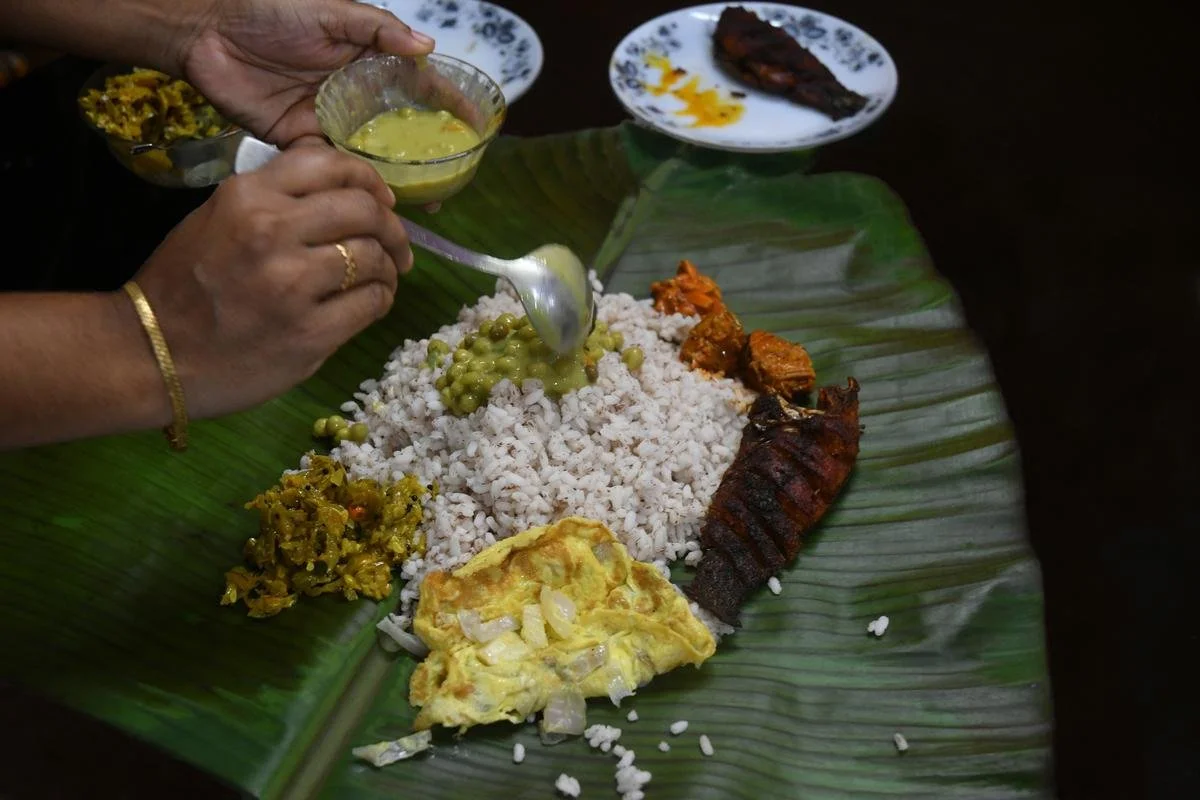Fugias & the Hands that Make this East Indian Specialty

Mumbai’s East Indian fugia is an airy, soft, deep-fried bread that is eaten alongside curries, with tea, or savoured entirely on its own. The women who make and sell this beloved balloon bread have taken a hit thanks to the pandemic, struggling to keep this tradition alive.
“During a wedding, the ladies make fugias. And when the first lot comes out — somewhere between 100-200 fugias — the ladies will shout, ‘Call the children, call them, call them!’” Libina Tixeira, 56, an East Indian mother, shares the tradition behind fugias in one long breath.
Fugias are round, deep-fried morsels of bread, made by East Indians, a small community of Catholics in Mumbai, or as they say, Mobai. The term 'East Indian’ was adopted to distinguish themselves from the Portuguese Catholic immigrants from Goa, as one of the city's original inhabitants.
The name fugia, from the Marathi word fugga, which translates to balloon, encompasses a crucial aspect of a successful fugia — airiness. Crisp on the outside, soft on the inside. Often, it will have a sweetness that blends perfectly with spicy curries like vindaloo and sorpotel, but is still delicious enough to be eaten on its own at tea-time. However, it is important to note there are salty variations, too.
Fugias, fugyas or fugiyas are made during weddings but also for celebrations like Church feasts and Christmas. “It’s the symbol of weddings!” Libina says. “They’ll ask me, ‘Libina, when will I get fugias?’ They really mean, ‘Libina when will my daughter get married?’”
Marie Pereira, 62, resident of Kondivita, Andheri, in the heart of Mumbai Suburban, says, “Our weddings are never complete without it.” East Indians will churn out 500 (or more) fugias during a wedding, made by an army of women scooping dough into a kadai, and a man, someone’s uncle or husband, overseeing the frying. This is the exact image to call up when one thinks of its preparation. It is at these family gatherings, preparing fugias, wedding rice, and pickles, that traditions are passed on.
Like almost every East Indian, 64-year-old Theresa Cascar’s knowledge of the cuisine came from her mother. Theresa owns Troy Snacks in Malad, a suburb north of the city, where she sells East Indian dishes from the open lobby of her residence. She says that while she was at boarding school, the nuns would call on 18-year-old Theresa to make bread for feasts and celebrations. So well known was her skill.
But from where did the fugia come? Chef Michael Swamy credits its origin to South America, where fugias are beloved in Argentina, Mexico and Brazil. “The making of bread with yeast,” he notes, “come from the Spanish and Portuguese who introduced it to India.”
Less than two decades ago, fugias became available for sale within the community, made mostly by women. They would sell their wares, for income, or love of the bread, to those who couldn't be bothered with preparing it at home. With an absence of caterers, or shops selling such delicacies, these women, equipped with years of experience, founded their business.
For Chef Gracian De Souza’s 2018 Bombay Vintage pop-up in south Mumbai’s Colaba, which celebrated food from across Catholic communities in the city, fugias were sourced “from an aunty in Bandra.” Chef Michael, author of East Indian Kitchen, often hires their expertise in his restaurant on festive occasions, as their flavours are both authentic and unmatched.
Image credit: East Indian Memory Co.
The batter is blessed and marigold flowers are added to it before fugias are formed and
fried for a wedding. Photo credit: Rochelle Tixeira
If you need to buy fugias, you’d probably need to know an East Indian to direct you to an ‘aunty’ who sells them. Other than homemakers, fugias are found at local ‘Catlik’ stores like 20th Century Stores in Malad’s Orlem, opposite Our Lady of Lourdes Church, or The Family Table, by Joseph’s, in Bandra. Or better yet, find a church in an East Indian pocket. There will always be a woman with a stall (just a table and a chair) selling fugias, among other favourites like potato chops, ribbon sandwiches and cutlets.
During the lockdown, due to a very well-known virus, many home chefs couldn’t head to their usual selling spots. Businesses that stood at a single location for years, or attracted Sunday Mass-goers, lost many sales. There was neither a place to set up a table, nor customers. Despite selling directly from their homes on pre-order basis, they saw a drop in sales.
Before the pandemic, Theresa would fire up the stove, dropping fugia dough into hot oil, on the street in front of her residence. Her husband and regular customers would stand around, chatting. “Someone would get the aroma of whatever I’m cooking and ask about it,” Theresa narrates.
But the lockdown proved hard, and sales were shifted to mainly pre-orders, which were fewer than before. "Fugias are made only on Sundays," she says, selling close to seven kilograms before the lockdown. On opening her shop in the second week of December, after nearly nine months, she sold two kilograms of the balloon bread.
Regina Pereira, 64, from Vasai, located further north of Mumbai, witnessed a slack in business at the start of the lockdown. While orders have picked up, they aren’t what they used to be. “[Loyal] customers want homemade food, and they trust me for safe and authentic East Indian dishes,” says Regina, whose daughter founded East Indian Memory Co., a popular repository of East Indian art and culture.
Ashu D’Penha, 62, of Ashu’s Kitchen, a home-enterprise based in Kurla, notes a drop in sales in the last ten months. She says that fugia and varia — salty donut-shaped bread — orders would come in two to three times a month, now it’s once in two months. She’s been making fugias since she was a 17 year-old, and selling them since 2002, even setting up a stall outside Holy Cross Church, Kurla, every weekend with her best friend.
These home chefs, comprising mostly women between their 40s and 60s, have made not just fugias, but East Indian cuisine, a local business. It was with them that culinary traditions were shared within the Catholic community and outside, way before cultural committees came together to bring forth an East Indian dictionary, museum and events, in the hope of keeping the culture thriving.
On the other hand, many from the younger generation have spotted an opportunity during the crisis. While some ventured into their kitchens with traditional recipes, others offered social media support for their parents to reach customers.
During the lockdown, 27-year-old Steffi Fernandes from Dadar launched Crumble and Crown on Instagram with her mother. Being Goan, fugias are the only East Indian dish on her menu. They learnt the technique from East Indian relatives in Uttan, a coastal town north of Mumbai. “People love fugias, so we make them,” Steffi says happily.
From Orlem, Malad, Nigel D’souza’s own Fugia Fam was opened months after the lockdown when sourcing the bread became a problem for friends, and making it at home an even bigger one. “Where there’s demand, we supply,” says the 26-year-old. Fugia Fam is a family venture. While Nigel markets the brand on social media, “Mum [Merlyn D’souza, 54] makes the dough, dad fries it,” he explains. “We’ve grown through Instagram and word-of-mouth alone.”
A novice fugia-maker would think that its reservations for celebrations would be the result of a tricky recipe. But masters of the technique disagree. The traditional method has the maker press out dough balls between the thumb and forefinger with one hand, and scoop it with the other, into a kadai. “If you watch Youtube now, they’re even showing how to make fugias with the help of a spoon to form the balls,” says Marie. When asked how to identify a perfect batter, Ashu says, “The dough should easily fluff up when you squeeze it... If it does not, your dough is bad.”
The hand that makes it is very important in fugia-making. Libina’s daughter, Rochelle Tixeira equates the technique of making fugias to its taste as well. She says, “The hand is different, the taste is different.”
Theresa shares her stove with a friend, Lourdes. The two, who have been cooking alongside each other for the last 20 years, have subtle yet noticeable differences in their food. Regulars at their shop will know who’s made what.
East Indian Marathi, as it’s called, is not a written dialect. Recipes are stored in the hands of the makers as much as their minds. And with every house tweaking their version to make successfully airy fugias, the recipe has undergone an evolution. Fugias have been risen with toddy, then Khamir, (dry yeast) and, a new replacement, Eno as the fermenting agent.
But tweaks are accepted within their limits. Eno is an abomination. Khamir is tradition. Not many remember their grandmothers using toddy. “Proper East Indian cooking is using the ingredients your ancestors used. I don’t want to change that,” says Regina.
A watercolour illustration of fugias by the author
Women gathered to make fugias at a wedding. Photo credit: Ashu D’Penha
When it comes to a lesser-known cuisine, people are curious to try dishes that are ‘authentic’. Sometimes authenticity lies in tested tricks, sometimes new additions, and even untouched recipes handed down from generation to generation, mastered with years of experience. In this case, the expertise of making fugias lie with a small, vibrant community of East Indians.
Theresa Cascar and Lourdes
Troy Snacks at Orlem, Malad
Ph: +91 9869313357
Ashu D’Penha
Ashu’s Kitchen at Kurla
Ph: +91 9969688592, +91 9969961611
East Indian Memory Co. Fine Foods
East Indian Memory Co., Vasai Village
Ph: +91 9823705936
Crumble and Crown
Steffi Fernandes at Dadar
Ph: +91 9920212801
Fugia Fam
Nigel D’souza at Orlem, Malad
Ph: +91 9619441315
Banner image: Nigel D'Souza of Fugia Fam
Tanishka D'Lyma is a freelance journalist and advertising professional. She writes about all things art, culture and her sister, Kay D'Lyma's baking. Her writing has been featured in Art & Deal and Firstpost among others.
ALSO ON THE GOYA JOURNAL











